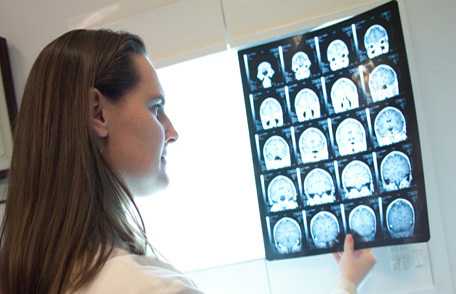Preventing Traumatic Brain Injury
 Prevent TBI by understanding the risks, signs, and symptoms. Improve the health and quality of life for TBI survivors.
Prevent TBI by understanding the risks, signs, and symptoms. Improve the health and quality of life for TBI survivors.
This March, in recognition of Brain Injury Awareness Month, CDC is working to raise awareness about traumatic brain injury (TBI). Improved prevention, recognition, and response can help address this important public health problem.
Understanding TBI
Have you ever hit your head as a result of a fall, car crash, or other type of activity and just "did not feel right" afterwards? After a few days, you returned to your normal activities, but continued to experience headaches, sensitivity to noise, or difficulty concentrating and remembering things. Does this sound familiar?

A TBI can disrupt the normal functions of the brain. TBIs—ranging from mild concussions to severe, life-threatening injuries—can be prevented. The burden of TBI can be reduced through prevention strategies and improvements in the health and quality of life for people living with a TBI.
Research shows that in the United States:
- males have higher rates of TBI compared to women,
- the youngest children and older adults are at highest risk for sustaining fall-related TBIs,
- adolescents and young adults (persons aged 15–24 years) have the highest rates of motor vehicle-related TBIs, and
- adults aged 65 years or older have the highest rates of TBI-related hospitalization and are more likely to die from TBI (either TBI alone or along with other injuries or illnesses) than any other age group.1
Learning the Signs and Symptoms
Many people who have a TBI recover quickly. But for some people, TBI symptoms can last for days, weeks, or longer. In general, recovery may be slower for older adults, young children, and teens. In severe cases, a TBI can lead to coma and even death. People who have had a TBI in the past are at greater risk of having another one and may find that it takes longer to recover if they have another TBI.
Symptoms of TBI usually fall into four categories
 Thinking/Remembering
Thinking/Remembering |
 Physical
Physical |
 Emotional/Mood
Emotional/Mood |
 Sleep
Sleep |
|---|---|---|---|
| Difficulty thinking clearly | Headache Fuzzy or blurry vision |
Irritability | Sleeping more than usual |
| Feeling slowed down | Nausea or vomiting (early on) Dizziness |
Sadness | Sleeping less than usual |
| Difficulty concentrating | Sensitivity to noise or light Balance problems |
More emotional | Trouble falling asleep |
| Difficulty remembering new information | Feeling tired, having no energy | Nervousness or anxiety |
Some of these symptoms occur at the time of the injury. Other symptoms may not be noticed for days or months after the injury, when a person returns to their everyday life.
See When to Seek Immediate Medical Attention, to learn about danger signs to watch for among adults and children.
Getting Help
People with a TBI need to be seen by a health care professional. Contact your health care professional if you think you or someone you know has a TBI. Your health care professional can refer you to a neurologist, neuropsychologist, neurosurgeon, or specialist in rehabilitation such as a speech pathologist. Getting help soon after the injury by trained specialists may speed recovery.

Getting Better
Rest is very important after a TBI because it helps the brain to heal. Ignoring your symptoms and trying to "tough it out" often makes symptoms worse. Be patient because healing takes time. Only when your symptoms have reduced significantly—and you have the approval of your health care professional—should you slowly and gradually return to your daily activities, such as work or school. If your symptoms come back or you get new symptoms as you become more active, this is a sign that you are pushing yourself too hard. Stop these activities and take more time to rest and recover. As the days go by, you can expect to gradually feel better. If you do not think you are getting better, tell your doctor. See Getting Better for tips to help aid recovery from a TBI. You can also learn more about returning to activities after a mild TBI.
Reaching Out
Several organizations offer help for people and their families who deal with concussion and more serious TBIs. They provide information and connect people with local resources such as support groups, rehabilitation services, and various health care professionals.
See Finding Support for more information, including contacting support groups in your area.
Learn more information about TBI in the military, including an interactive website for service members, veterans, and families and caregivers.
Improving Research
Research and data are critical to understanding traumatic brain injury as an important public health problem. CDC collects and reports TBI data to help inform prevention strategies, identify research and education priorities, and to support the need for services among those living with a TBI.
Helping Spread the Word
CDC developed the "Heads Up" educational initiatives to help improve prevention, recognition, and response to TBI, including concussions. Heads Up offers information to health care professionals, school professionals, sports coaches, parents, athletes, and others.
Reference
- CDC. Traumatic brain injury in the United States: emergency department visits, hospitalizations, and deaths, 2002–2006. Atlanta, GA: US Department of Health and Human Services; CDC 2010. Available at https://www.cdc.gov/traumaticbraininjury/pdf/blue_book.pdf. [1.9 MB]
More Information
More Information
- Celebrate 10 Years of Being Heads Up to Concussion:
- Read how CDC's Heads Up has helped raise awareness for improved prevention, recognition, and response to concussion and other serious brain injuries in the Heads Up 10 Year Anniversary Viewbook [8.89 MB].
- Check out what's new for parents:
- We partnered with the CDC Foundation to create the Heads Up to Parents website just for parents. It makes it easy to help keep children healthy, safe, and injury free.
- Get the Heads Up app:
- Use the Heads Up App for easy access to information about what to look for and what to do if you think your child may have a concussion. The app is also helpful for selecting an appropriate helmet.
- Learn how teachers can help injured students:
- Heads Up to Schools Classroom Tips for Teachers [765 KB] offers real world advice about how teachers can help students get back on track and ready to learn after a concussion.
- Read a Survivor Story:
- Listen to a Radio PSA
- Send a TBI Health-e-Card
- Page last reviewed: March 17, 2014
- Page last updated: March 17, 2014
- Content source:
- National Center for Injury Prevention and Control
- Page maintained by: Office of the Associate Director for Communication, Digital Media Branch, Division of Public Affairs




 ShareCompartir
ShareCompartir